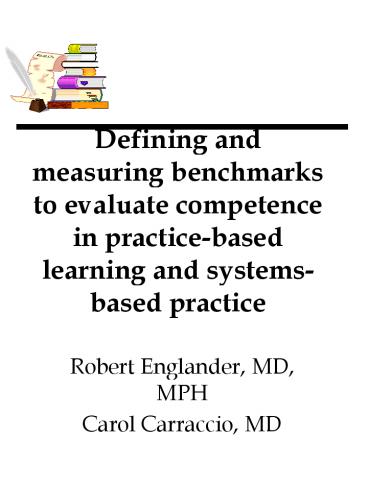Defining and measuring benchmarks to evaluate competence in practicebased learning and systemsbased - PowerPoint PPT Presentation
1 / 17
Title:
Defining and measuring benchmarks to evaluate competence in practicebased learning and systemsbased
Description:
Review benchmarks for domains of competence in practice-based learning and ... Three tools were developed to address competence in PBL & I and SBP ... – PowerPoint PPT presentation
Number of Views:66
Avg rating:3.0/5.0
Title: Defining and measuring benchmarks to evaluate competence in practicebased learning and systemsbased
1
Defining and measuring benchmarks to evaluate
competence in practice-based learning and
systems-based practice
- Robert Englander, MD, MPH
- Carol Carraccio, MD
2
Learning Objectives
- Learn the 4 step process to developing a
competency-based system of education - Review benchmarks for domains of competence in
practice-based learning and systems-based
practice - Review criteria for evaluating competence in
practice-based learning systems-based practice
3
Paradigm Comparison
4
The ProcessStep 1
- Defining broad competencies
- (ACGME)
- Refining competencies
- (specialty quads)
- Developing benchmarks or performance indicators
for each of the competencies - (attempted by us)
5
Step 1 Defining the Competencies
- Patient care
- Medical Knowledge
- Professionalism
- Interpersonal skills and communication
- Practice-based learning and improvement
- Systems-based practice
6
Step 1 Refining the Competencies
- PATIENT CARE
- Residents must be able to provide family
centered patient care that is developmentally age
appropriate, compassionate, and effective for the
treatment of health problems and the promotion of
health.
7
Step 2- Phase 1 Defining Benchmarks
- Competency Use information technology, peer
review, and self assessment to promote life-long
learning - Knowledge/Skills/Attitudes Benchmarks
- Uses feedback to identify areas for improvement
- Seeks opportunities to strengthen deficits in
knowledge/skills (e.g. specific electives,
didactic opportunities, information technology
resources, etc)
8
Step 2- Phase 2 Setting Thresholds
- Setting Thresholds
- Defining types of thresholds
- Applying the appropriate type of threshold to
each benchmark under each competency
9
Achieving Consensus
- Survey sent to all members of the Association of
Pediatric Program Directors - Consensus defined as gt 50 of directors agreeing
on a specific threshold - For those benchmarks with lt 50 agreement at
single level, the threshold was dropped to the
next level down until gt 50 consensus was reached
10
Step 2- Phase 3 Consensus on Thresholds
- For the majority of benchmarks there was clear
consensus regarding the threshold for the
benchmark based on level of experience - Most discrepancies occurred in defining
thresholds within the first year - Consensus reached for 95 of benchmarks at PGY-2
level and 100 at PGY-3
11
The Process Step 3
- Evaluating Competence
- Creating a portfolio
- Three tools were developed to address competence
in PBL I and SBP
12
Practice based Learning and Improvement
- Practice Improvement Project
- 15 total benchmarks
- Project measures half of the benchmarks
- Team QA project in a continuity clinic setting
- Detailed instructions for learners
- Criteria for judging competence for faculty
preceptors
13
Systems-based Practice
- Two Projects
- Together they measure half of the 17 benchmarks
- Detailed instructions for learners
- Criteria for judging competence for faculty
14
Systems-based Practice
- Navigating the System
- Builds on practice improvement project with the
- Resident outlines a plan to further improve
quality by using potential resources outside of
the immediate system
15
Systems-based Practice
- System Errors
- Learner identifies a system error and outlines
strategies to rectify it which are at a system
level
16
Next Steps
- Study the reliability and validity of the newly
created tools - Create additional tools and venues for residents
to demonstrate competence in the remaining
benchmarks
17
The Process Step 4
- Evaluating the Process
- Reviewing each of the prior steps for efficacy
- (Phase 4 of the ACGME Outcomes Project 2011)































